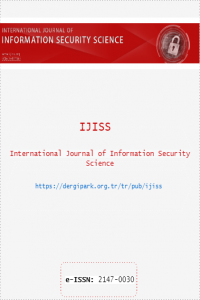Privacy Issues on Social Networks
Privacy Issues on Social Networks
The privacy is a need for humanity since the creation of civilizations. In social networks SNs the common point is that each user has to create a profile to define his or her own identity. The profile description includes many items with privacy settings to tune their visibility degrees for only owner, friends, friends of friends FoF and sometimes for public. After enrolment stage, users extend their social connection graphs with accepted new friends and these graphs grow without the control of individual due to the new FoF. Hence, with high probability, the shared information of member is generally available to public and can be retrieved by users around the world. In this article, the reasons of privacy concerns, and which intensively works have done or required to produce solutions by researchers and governments will be evaluated.
Keywords:
Privacy, social networks, data privacy regulations, information spreading, privacy policies static and dynamic big data analysis,
___
- 1]. H. Hsiao-Ying; M. Bashir, "Is privacy a human right? An empirical examination in a global context," in Privacy, Security and Trust (PST), 13th Annual Conference on, vol., no., pp.77-84, 21-23 doi: 10.1109/PST.2015.7232957, July 2015.
- [2]. A. Ho, A. Maiga, and E. Aimeur. “Privacy protection issues in social networking sites”, In 2009 IEEE/ACS International Conference on Computer Systems and Applications, pages 271–278, May 2009.
- [3]. V. Tuunainen, O. Pitkänen, and M. Hovi, "Users’ Awareness of Privacy on Online Social Networking Sites – Case Facebook", BLED 2009 Proceedings. 42, http://aisel.aisnet.org/bled2009/42, 2009.
- [4]. J. Min, and B. Kim, “How are people enticed to disclose personal information despite privacy concerns in social network sites? The calculus between benefit and cost”, JASIST, 66: 839–857. doi: 10.1002/asi.23206, 2015.
- [5]. L. Fang and K. LeFevre. “Privacy wizards for social networking sites”, In Proceedings of the 19th international conference on World wide web (WWW'10). ACM, New York, NY, USA, 351-360. doi=10.1145/1772690.1772727 http://doi.acm.org/10.1145/1772690.1772727, 2010.
- [6]. N. Talukder, M. Ouzzani, A. Elmagarmid, H. Elmeleegy, “Privometer: Privacy protection in social networks”, vol. 1, no. 2. VLDB Endowment, pp. 141– 150, 2010
- [7]. Y. Wang, R.K. Nepali, and J. Nikolai. “Social network privacy measurement and simulation”, In Computing, Networking and Communications (ICNC), 2014 International Conference on, vol., no., pp.802-806, 3-6 doi: 10.1109/ICCNC.2014.6785440, Feb. 2014.
- [8]. T. L. James, M. Warkentin, and S. E. Collignon. “A dual privacy decision model for online social networks”, Inf. Manage., 52(8):893–908, December 2015.
- [9]. C. Dong, H. Jin, and B. Knijnenburg. “Predicting privacy behavior on online social networks” Ninth International AAAI Conference Web and Social Media, April 2015.
- [10]. C. Dong, H. Jin, and B. P. Knijnenburg, “PPM: A Privacy Prediction Model for Online Social Networks”, In: Spiro E., Ahn YY. (eds) Social Informatics. SocInfo 2016. Lecture Notes in Computer Science, vol 10047. Springer, Cham, https://doi.org/10.1007/978-3-319-47874-6_28, 2016.
- [11]. E. Aghasian, S. Garg, L. Gao, S. Yu, and J. Montgomery, “Scoring users’ privacy disclosure across multiple online social networks”, IEEE Access, 5:13118–13130, 2017.
- [12]. A. Srivastava and G. Geethakumari. “Measuring privacy leaks in online social networks”, In 2013 International Conference on Advances in Computing, Communications and Informatics (ICACCI), pp 2095– 2100, Aug 2013.
- [13]. D. Wang, X. Zeng, and J. A. Keane. “A simplified structure evolving method for Mamdani fuzzy system identification and its application to high-dimensional problems”, Information Sciences, 220(Supplement C):110 – 123. Online Fuzzy Machine Learning and Data Mining, 2013.
- [14]. P.S. Bayerl and B. Akhgar. “Surveillance and falsification implications for open source intelligence investigations”, Commun. ACM 58, 8, 62-69. DOI=10.1145/2699410 http://doi.acm.org/10.1145/2699410, July 2015.
- [15]. L. Schwittmann, C. Boelmann, M. Wander, and T. Weis, “SoNet -- Privacy and Replication in Federated Online Social Networks”, In Proceedings of the 2013 IEEE 33rd International Conference on Distributed Computing Systems Workshops (ICDCSW '13). IEEE Computer Society, Washington, DC, USA, 51-57. DOI=10.1109/ICDCSW.2013.20 http://dx.doi.org/10.1109/ICDCSW.2013.20, 2013.
- [16]. K.M. Deirdre and A.B. Kenneth. “What regulators can do to advance privacy through design”, Commun. ACM 56, 11, 20-22. DOI=10.1145/2527185 http://doi.acm.org/10.1145/2527185, November 2013.
- [17]. Guide to the General Data Protection Regulation (GDPR), https://ico.org.uk/for-organisations/guide-tothe-general-data-protection-regulation-gdpr/ Latest Access Time for the website is 06 June 2018.
- [18]. A. Karatas, S. Sahin, “A Review on Social Bot Detection Techniques and Research Directions”, in Proceedings of the 10th International Conference on Information Security and Cryptology (ISCTurkey 2017), Article No. 29, Ankara, Turkey, October 20- 21,2017, pp. 156- 161. Accessed on Oct. 30,2017[Online]
- [19]. Y. Bao, C. Yi, Y. Xue, and Y. Dong. “A new rumor propagation model and control strategy on social networks”, In Proceedings of the 2013 IEEE/ACM International Conference on Advances in Social Networks Analysis and Mining (ASONAM '13). ACM, New York, NY, USA, 1472-1473, DOI=http://dx.doi.org/10.1145/2492517.2492599, 2013.
- [20]. E. Serrano, C. Á. Iglesias, and M. Garijo, “A Novel Agent-Based Rumor Spreading Model in Twitter”, In Proceedings of the 24th International Conference on World Wide Web (WWW '15 Companion). ACM, New York, NY, USA, 811-814. DOI: http://dx.doi.org/10.1145/2740908.2742466, 2015.
- [21]. G. Cordasco, L. Gargano, A. A. Rescigno, and U. Vaccaro, “Brief Announcement: Active Information Spread in Networks”, In Proceedings of the 2016 ACM Symposium on Principles of Distributed Computing (PODC '16). ACM, New York, NY, USA, 435-437. DOI: http://dx.doi.org/10.1145/2933057.2933069, 2016. [ 22]. Chao Tong, Wenbo He, Jianwei Niu and Zhongyu Xie, “A novel information cascade model in online social networks”, Physica A: Statistical Mechanics and its Applications, Volume 444, p. 297-310. DOI:10.1016/j.physa.2015.10.026, 2015.
- [23]. B. Sayin, S. Sahin, “A Novel Approach to Information Spreading Models for Social Networks”, IARIA, The Sixth International Conference on Data Analytics Conference 2017, ISBN: 978-1-61208-603-
- Yayın Aralığı: Yılda 4 Sayı
- Başlangıç: 2012
- Yayıncı: Şeref SAĞIROĞLU
